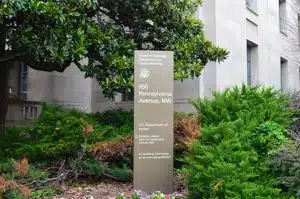(The Center Square) – President Donald Trump issued an executive order on Monday to enhance national security and enforce federal immigration and criminal law in so-called sanctuary jurisdictions and take a range of actions against those obstructing enforcement, including eliminating their federal funding.
Trump’s “Protecting American Communities from Criminal Aliens” executive order directs the departments of Justice and Homeland Security to publish a list of state and local jurisdictions that obstruct federal immigration enforcement and take action against them.
“Federal supremacy with respect to immigration, national security, and foreign policy is axiomatic,” the order states, citing Article II and Article IV, Section 4, of the U.S. Constitution, vesting the federal government with the power to protect national security and “protect each of [the States] against Invasion.”
The invasion argument was first made by 55 Texas counties that declared an invasion citing Article IV, Section 4 of the U.S. Constitution, The Center Square exclusively reported.
“The prior administration allowed unchecked millions of aliens to illegally enter the United States,” the order states, creating a public safety and national security crisis, exacerbated by transnational criminal organizations, terrorists and others intent on harming Americans.
Trump’s latest executive order, as many of his previous ones, is likely to be challenged in court.
Citing an invasion at the southern border, which Trump officially declared on his first day in office, his administration is now responding to some state and local officials who “violate, obstruct, and defy” federal immigration enforcement, the order states.
Local jurisdictions who obstruct federal deportation efforts are engaging in “a lawless insurrection against the supremacy of Federal law and the Federal Government’s obligation to defend the territorial sovereignty of the United States,” it states.
In addition to creating “intolerable national security risks,” the order states sanctuary jurisdictions’ “nullification efforts often violate Federal criminal laws, including those prohibiting obstruction of justice, … unlawfully harboring or hiring illegal aliens …, conspiracy against the United States …, and conspiracy to impede Federal law enforcement.”
The order also notes that “assisting aliens in violating Federal immigration law could also violate the Racketeer Influenced and Corrupt Organizations Act,” an argument made by America First Legal, The Center Square reported. In January, AFL launched a resource to help Americans fight sanctuary policies and sent letters to more than 250 elected officials demanding that they comply with federal law or expect to be sued.
“Concealing, harboring, or shielding aliens could also trigger liability under the federal Racketeer Influenced and Corrupt Organizations Act (RICO) statute,” AFL said. “Civil RICO remedies are available to ‘[a]ny person injured in his business or property by reason of a violation’ and shall recover threefold the damages he sustains and the cost of the suit, including a reasonable attorney’s fee.’”
Trump’s order also states that those who assist illegal foreign nationals might be violating federal laws that prohibit discrimination against Americans and might be violating Americans’ civil rights.
In order for the federal government “to restore the enforcement of United States law,” Trump directed the attorney general and Secretary of Homeland Security to publish a list of states and local jurisdictions that obstruct the federal immigration enforcement. Each jurisdiction is to be notified of its alleged violation of federal immigration and criminal law.
Those that remain in defiance will lose all federal funding, the order says. The AG and DHS secretary are directed to work with the Director of the Office of Management and Budget to identify, suspend and terminate all federal funds allocated to sanctuary jurisdictions, including grants and contracts. They are also directed to “pursue all necessary legal remedies and enforcement measures to end these violations and bring such jurisdictions into compliance” with U.S. laws.
The order also prevents all federal benefits from being spent on illegal foreign nationals living in sanctuary jurisdictions, including through private entities. It requires federal agencies to create a mechanism “to ensure appropriate eligibility verification is conducted for individuals receiving federal public benefits” under Title 8 of federal immigration law.
It also creates provisions for the AG, DHS secretary and agency heads to “identify and take appropriate action to stop the enforcement of state and local laws, regulations, policies, and practices favoring aliens over any groups of American citizens that are unlawful, preempted by federal law, or otherwise unenforceable.”
This includes state laws that provide in-state higher education tuition “to aliens but not to out-of-State American citizens that may violate” federal law or “that favor aliens in criminal charges or sentencing.”
The order was issued after the Trump administration already warned sanctuary jurisdictions like Massachusetts, whose officials remained steadfast in their policies to protect illegal foreign nationals. They continued to do so after federal authorities arrested alleged terrorists tied to the murder of U.S. troops and hundreds of criminal illegal foreign nationals were charged or convicted of committing violent crimes against Massachusetts residents, The Center Square reported.


















































